Comparison of Catalytic Activity of ZIF-8 and Zr/ZIF-8 for Greener Synthesis of Chloromethyl Ethylene Carbonate by CO2 Utilization
Abstract
:1. Introduction
2. Experimental Methods
2.1. Chemicals and Materials
2.2. Catalysts Preparation
2.3. Experimental Procedure for the Synthesis of Chloromethyl Ethylene Carbonate (CMEC)
2.4. Method of Analysis
2.5. Proposed Reaction Mechanism
- ▪
- The ring-opening of epoxides by a catalyst;
- ▪
- Incorporation of carbon dioxide into the opening to form the cyclic carbonate.
2.6. Catalyst Characterization
3. Results and Discussion:
Catalyst Characterization
4. Catalytic Activity
4.1. Effect of Different Heterogeneous Catalysts
4.2. Effect of Temperature
4.3. Effect of CO2 Pressure
4.4. Influence of Reaction Time
4.5. Effect of External Mass Transfer in Heterogeneous Catalytic Processes
4.6. Effect of Catalyst Loading
4.7. Effect of Reaction Conditions on Catalysts Selectivity to Chloromethyl Ethylene Carbonate
4.8. Reusability of ZIF-8 Catalysts
5. Conclusions
Author Contributions
Funding
Acknowledgments
Conflicts of Interest
References
- Dai, W.L.; Luo, S.L.; Yin, S.F.; Au, C.T. The direct transformation of carbon dioxide to organic carbonates over heterogeneous catalysts. Appl. Catal. A Gen. 2009, 366, 2–12. [Google Scholar] [CrossRef]
- Saada, R.; AboElazayem, O.; Kellici, S.; Heil, T.; Morgan, D.; Lampronti, G.I.; Saha, B. Greener synthesis of dimethyl carbonate using a novel tin-zirconia/graphene nanocomposite catalyst. Appl. Catal. B Environ. 2018, 226, 451–462. [Google Scholar] [CrossRef] [Green Version]
- Baj, S.; Krawczyk, T.; Jasiak, K.; Siewniak, A.; Pawlyta, M. Catalytic coupling of epoxides and CO2 to cyclic carbonates by carbon nanotube-supported quaternary ammonium salts. Appl. Catal. A Gen. 2014, 488, 96–102. [Google Scholar] [CrossRef]
- Adeleye, A.I.; Kellici, S.; Heil, T.; Morgan, D.; Vickers, M.; Saha, B. Greener synthesis of propylene carbonate using graphene-inorganic nanocomposite catalysts. Catal. Today 2015, 256, 347–357. [Google Scholar] [CrossRef]
- Onyenkeadi, V.; Kellici, S.; Saha, B. Greener synthesis of 1,2-butylene carbonate from CO2 using graphene-inorganic nanocomposite catalyst. Energy 2018, 165, 867–876. [Google Scholar] [CrossRef]
- Kathalikkattil, A.C.; Babu, R.; Tharun, J.; Roshan, R.; Park, D.W. Advancements in the Conversion of Carbon Dioxide to Cyclic Carbonates Using Metal Organic Frameworks as Catalysts. Catal. Surv. Asia 2015, 19, 223–235. [Google Scholar] [CrossRef]
- Karagiaridi, O.; Lalonde, M.B.; Bury, W.; Sarjeant, A.A.; Farha, O.K.; Hupp, J.T. Opening ZIF-8: A catalytically active zeolitic imidazolate framework of sodalite topology with unsubstituted linkers. J. Am. Chem. Soc. 2012, 134, 18790–18796. [Google Scholar] [CrossRef]
- Beyzavi, M.H.; Stephenson, C.J.; Liu, Y.; Karagiaridi, O.; Hupp, J.T.; Farha, O.K. Metal Organic Framework-Based Catalysts: Chemical Fixation of CO2 with Epoxides Leading to Cyclic Organic Carbonates. Front. Energy Res. 2015, 2, 1–10. [Google Scholar] [CrossRef] [Green Version]
- Rimoldi, M.; Howarth, A.J.; Destefano, M.R.; Lin, L.; Goswami, S.; Li, P.; Hupp, J.T.; Farha, O.K. Catalytic Zirconium/Hafnium-Based Metal-Organic Frameworks. ACS Catal. 2017, 7, 997–1014. [Google Scholar] [CrossRef]
- Zhang, X.; Zhang, X.; Johnson, J.A.; Chen, Y.S.; Zhang, J. Highly Porous Zirconium Metal-Organic Frameworks with β-UH3-like Topology Based on Elongated Tetrahedral Linkers. J. Am. Chem. Soc. 2016, 138, 8380–8383. [Google Scholar] [CrossRef] [Green Version]
- Jeong, H.-M.; Roshan, R.; Babu, R.; Kim, H.-J.; Park, D.-W. Zirconium-based isoreticular metal-organic frameworks for CO2 fixation via cyclic carbonate synthesis. Korean J. Chem. Eng. 2017, 35, 438–444. [Google Scholar] [CrossRef]
- Yang, X.; Qiu, L.; Luo, X. ZIF-8 derived Ag-doped ZnO photocatalyst with enhanced photocatalytic activity. RSC Adv. 2018, 8, 4890–4894. [Google Scholar] [CrossRef] [Green Version]
- Bai, Y.; Dou, Y.; Xie, L.-H.; Rutledge, W.; Li, J.-R.; Zhou, H.-C. Zr-based metal–organic frameworks: Design, synthesis, structure, and applications. Chem. Soc. Rev. 2016, 45, 2327–2367. [Google Scholar] [CrossRef] [PubMed]
- Marshall, R.J.; Forgan, R.S. Postsynthetic Modification of Zirconium Metal-Organic Frameworks. Eur. J. Inorg. Chem. 2016, 2016, 4310–4331. [Google Scholar] [CrossRef]
- Jin, Z.; Yang, H. Exploration of Zr–Metal–Organic Framework as Efficient Photocatalyst for Hydrogen Production. Nanoscale Res. Lett. 2017, 12, 850–854. [Google Scholar] [CrossRef] [PubMed]
- Cavka, J.H.H.; Jakobsen, S.; Olsbye, U.; Guillou, N.; Lamberti, C.; Bordiga, S.; Lillerud, K.P.P. A New Zirconium Inorganic Building Brick Forming Metal Organic Frameworks with Exceptional Stability. J. Am. Chem. Soc. 2008, 130, 13850–13851. [Google Scholar] [CrossRef]
- Jiang, M.; Cao, X.; Liu, P.; Zhang, T.; Zhang, J. ZIF-8@Polyvinylpyrrolidone Nanocomposites Based N-Doped Porous Carbon for Highly Efficient Oxygen Reduction Reaction in Alkaline Solution. J. Electrochem. Soc. 2016, 163, H459–H464. [Google Scholar] [CrossRef]
- Gong, Q.; Luo, H.; Cao, D.; Zhang, H.; Wang, W.; Zhou, X. Efficient cycloaddition reaction of carbon dioxide with epoxide by Rhodamine based catalyst under 1 atm pressure. Bull. Korean Chem. Soc. 2012, 33, 1945–1948. [Google Scholar] [CrossRef] [Green Version]
- Demir, S.; Usta, S.; Tamar, H.; Ulusoy, M. Solvent free utilization and selective coupling of epichlorohydrin with carbon dioxide over zirconium metal-organic frameworks. Microporous Mesoporous Mater. 2017, 244, 251–257. [Google Scholar] [CrossRef]
- Schejn, A.; Aboulaich, A.; Balan, L.; Falk, V.; Lalevée, J.; Medjahdi, G.; Aranda, L.; Mozet, K.; Schneider, R. Cu2+-doped zeolitic imidazolate frameworks (ZIF-8): Efficient and stable catalysts for cycloadditions and condensation reactions. Catal. Sci. Technol. 2015, 5, 1829–1839. [Google Scholar] [CrossRef]
- Thi Thanh, M.; Vinh Thien, T.; Thi Thanh Chau, V.; Dinh Du, P.; Phi Hung, N.; Quang Khieu, D. Synthesis of Iron Doped Zeolite Imidazolate Framework-8 and Its Remazol Deep Black RGB Dye Adsorption Ability. J. Chem. 2017, 2017, 5045973. [Google Scholar] [CrossRef] [Green Version]
- Sakakura, T.; Kohno, K. The synthesis of organic carbonates from carbon dioxide. Chem. Commun. 2009, 2, 1312–1330. [Google Scholar] [CrossRef] [PubMed]
- Al-Janabi, N.; Hill, P.; Torrente-Murciano, L.; Garforth, A.; Gorgojo, P.; Siperstein, F.; Fan, X. Mapping the Cu-BTC metal-organic framework (HKUST-1) stability envelope in the presence of water vapour for CO2 adsorption from flue gases. Chem. Eng. J. 2015, 281, 669–677. [Google Scholar] [CrossRef] [Green Version]
- Coşkun, S.; Taşçi, Z.; Ulusoy, M.; Yurdakoç, M. Catalytic conversion of carbon dioxide into cyclic carbonates by Cu(II) and Ni(II) acetylacetonates anchored onto Siral 80. Turk. J. Chem. 2014, 38, 600–610. [Google Scholar] [CrossRef]
- Saada, R. Catalytic Conversion of Carbon Dioxide (CO2) into Value Added Chemicals. Ph.D. Thesis, London South Bank University, London, UK, 2015. [Google Scholar]
- Gallardo-Fuentes, S.; Contreras, R.; Isaacs, M.; Honores, J.; Quezada, D.; Landaeta, E.; Ormazábal-Toledo, R. On the mechanism of CO2 electro-cycloaddition to propylene oxides. J. CO2 Util. 2016, 16, 114–120. [Google Scholar] [CrossRef]
- Nabipour, H.; Sadr, M.H.; Bardajee, G.R. Synthesis and characterization of nanoscale zeolitic imidazolate frameworks with ciprofloxacin and their applications as antimicrobial agents. New J. Chem. 2017, 41, 7364–7370. [Google Scholar] [CrossRef]
- Fan, G.; Zheng, X.; Luo, J.; Peng, H.; Lin, H.; Bao, M.; Hong, L.; Zhou, J. Rapid synthesis of Ag/AgCl@ZIF-8 as a highly efficient photocatalyst for degradation of acetaminophen under visible light. Chem. Eng. J. 2018, 351, 782–790. [Google Scholar] [CrossRef]
- Nordin, N.A.H.M.; Ismail, A.F.; Mustafa, A. Synthesis and preparation of asymmetric PSf/ZIF-8 mixed matrix membrane for CO2/CH4 separation. J. Teknol. (Sci. Eng.) 2014, 69, 73–76. [Google Scholar] [CrossRef] [Green Version]
- Zhu, M.; Srinivas, D.; Bhogeswararao, S.; Ratnasamy, P.; Carreon, M.A. Catalytic activity of ZIF-8 in the synthesis of styrene carbonate from CO2 and styrene oxide. Catal. Commun. 2013, 32, 36–40. [Google Scholar] [CrossRef]
- Da Silva, J.D.S.F.; Malo, D.L.; Bataglion, G.A.; Eberlin, M.N.; Ronconi, C.M.; Alves, S.; De Sá, G.F. Adsorption in a fixed-bed column and stability of the antibiotic oxytetracycline supported on Zn(II)-[2-methylimidazolate] frameworks in aqueous media. PLoS ONE 2015, 10, 1371–1381. [Google Scholar]
- Fang, Q.-R.; Makal, T.A.; Young, M.D.; Zhou, H.-C. Recent Advances in the Study of Mesoporous Metal-Organic Frameworks. Comments Inorg. Chem. 2010, 31, 165–195. [Google Scholar] [CrossRef]
- Panchariya, D.K.; Rai, R.K.; Anil Kumar, E.; Singh, S.K. Core-Shell Zeolitic Imidazolate Frameworks for Enhanced Hydrogen Storage. ACS Omega 2018, 3, 167–175. [Google Scholar] [CrossRef] [PubMed]
- Liu, J.; He, J.; Wang, L.; Li, R.; Chen, P.; Rao, X.; Deng, L.; Rong, L.; Lei, J. NiO-PTA supported on ZIF-8 as a highly effective catalyst for hydrocracking of Jatropha oil. Sci. Rep. 2016, 6, 1–11. [Google Scholar] [CrossRef] [PubMed]
- Na, L.Y.; Hua, R.N.; Ning, G.L.; Ou, X.X. Nano/Micro HKUST-1 Fabricated by Coordination Modulation Method at Room Temperature. Science 2012, 28, 555–558. [Google Scholar]
- Goyal, S.; Shaharun, M.S.; Kait, C.F.; Abdullah, B. Effect of monometallic copper on zeolitic imidazolate framework-8 synthesized by hydrothermal method. J. Phys. Conf. Ser. 2018, 1123, 6. [Google Scholar] [CrossRef]
- Cychosz, K.A.; Guillet-Nicolas, R.; García-Martínez, J.; Thommes, M. Recent advances in the textural characterization of hierarchically structured nanoporous materials. Chem. Soc. Rev. 2017, 46, 389–414. [Google Scholar] [CrossRef]
- Yin, H.; Kim, H.; Choi, J.; Yip, A.C.K. Thermal stability of ZIF-8 under oxidative and inert environments: A practical perspective on using ZIF-8 as a catalyst support. Chem. Eng. J. 2015, 278, 293–300. [Google Scholar] [CrossRef]
- North, M.; Pasquale, R.; Young, C. Synthesis of cyclic carbonates from epoxides and CO2. Green Chem. 2010, 12, 1514–1539. [Google Scholar] [CrossRef]
- Zanon, A.; Chaemchuen, S.; Mousavi, B.; Verpoort, F. 1 Zn-doped ZIF-67 as catalyst for the CO2 fixation into cyclic carbonates. J. CO2 Util. 2017, 20, 282–291. [Google Scholar] [CrossRef]
- Pang, S.H.; Han, C.; Sholl, D.S.; Jones, C.W.; Lively, R.P. Facet-specific stability of ZIF-8 in the presence of acid gases dissolved in aqueous solutions. Chem. Mater. 2016, 28, 6960–6967. [Google Scholar] [CrossRef]
- Zhou, K.; Mousavi, B.; Luo, Z.; Phatanasri, S.; Chaemchuen, S.; Verpoort, F. Characterization and properties of Zn/Co zeolitic imidazolate frameworks vs. ZIF-8 and ZIF-67. J. Mater. Chem. A 2017, 5, 952–957. [Google Scholar] [CrossRef]
- Bosch, M.; Zhang, M.; Zhou, H. Increasing the Stability of Metal-Organic Frameworks. Adv. Chem. 2014, 10, 18232–28237. [Google Scholar] [CrossRef]
- Xie, Y.; Wang, T.-T.; Liu, X.-H.; Zou, K.; Deng, W.-Q. Capture and conversion of CO2 at ambient conditions by a conjugated microporous polymer. Nat. Commun. 2013, 4, 1960–1967. [Google Scholar] [CrossRef] [PubMed] [Green Version]
- Zhou, L.; Li, N.; Owens, G.; Chen, Z. Simultaneous removal of mixed contaminants, copper and norfloxacin, from aqueous solution by ZIF-8. Chem. Eng. J. 2019, 362, 628–637. [Google Scholar] [CrossRef]
- Yao, J.; He, M.; Wang, K.; Chen, R.; Zhong, Z.; Wang, H. High-yield synthesis of zeolitic imidazolate frameworks from stoichiometric metal and ligand precursor aqueous solutions at room temperature. CrystEngComm 2013, 15, 3601–3606. [Google Scholar] [CrossRef]
- Giraldo, L.; Barranco, M.B.; Húmpola, P.; Carlos, J.; Piraján, M. the adsorption of phenols derivatives in aqueous solution. J. Chem. 2017, 8, 6940–6949. [Google Scholar]
- Song, Q.; Nataraj, S.K.; Roussenova, M.V.; Tan, J.C.; Hughes, D.J.; Li, W.; Bourgoin, P.; Alam, M.A.; Cheetham, A.K.; Al-Muhtaseb, S.A.; et al. Zeolitic imidazolate framework (ZIF-8) based polymer nanocomposite membranes for gas separation. Energy Environ. Sci. 2012, 5, 8359–8366. [Google Scholar] [CrossRef]
- Luanwuthi, S.; Krittayavathananon, A.; Srimuk, P.; Sawangphruk, M. In situ synthesis of permselective zeolitic imidazolate framework-8/graphene oxide composites: Rotating disk electrode and Langmuir adsorption isotherm. RSC Adv. 2015, 5, 46617–46623. [Google Scholar] [CrossRef]
- Mao, J.; Ge, M.; Huang, J.; Lai, Y.; Lin, C.; Zhang, K.; Meng, K.; Tang, Y. Constructing multifunctional MOF@rGO hydro-/aerogels by the self-assembly process for customized water remediation. J. Mater. Chem. A 2017, 5, 11873–11881. [Google Scholar] [CrossRef]
- Biswal, B.P.; Shinde, D.B.; Pillai, V.K.; Banerjee, R. Stabilization of graphene quantum dots (GQDs) by encapsulation inside zeolitic imidazolate framework nanocrystals for photoluminescence tuning. Nanoscale 2013, 5, 10556–10561. [Google Scholar] [CrossRef]
- Tanaka, S.; Fujita, K.; Miyake, Y.; Miyamoto, M.; Hasegawa, Y.; Makino, T.; Van Der Perre, S.; Cousin Saint Remi, J.; Van Assche, T.; Baron, G.V.; et al. Adsorption and Diffusion Phenomena in Crystal Size Engineered ZIF-8 MOF. J. Phys. Chem. C 2015, 119, 28430–28439. [Google Scholar] [CrossRef] [Green Version]
- Pham, T.T.; Le, L.N.; Nguyen, H.N.; Luong, T.T.K.; Pham, T.N.; Nguyen, H.L.; Nguyen, T.K. Encapsulating gold nanoparticles in zeolitic imidazolate framework crystal for novel optical response. Polyhedron 2018, 148, 171–177. [Google Scholar] [CrossRef]
- Wang, S.; Ma, Z.; Du, X.; Zhang, S.; Chen, Z. Lanthanum doping of metal-organic frameworks-5 and its effect on thermal stability and CO2 adsorption property. Mater. Express 2018, 8, 381–387. [Google Scholar] [CrossRef]
- Li, P.Z.; Wang, X.J.; Liu, J.; Lim, J.S.; Zou, R.; Zhao, Y. A Triazole-Containing Metal-Organic Framework as a Highly Effective and Substrate Size-Dependent Catalyst for CO2 Conversion. J. Am. Chem. Soc. 2016, 138, 2142–2145. [Google Scholar] [CrossRef] [PubMed]
- Abhang, R.M.; Wani, K.S.; Patil, V.S. Synthesis and Characterization of ZIF-8 Filler for Preparation of Mixed Matrix Membrane. Int. J. Sci. Eng. Res. 2015, 6, 1276–1280. [Google Scholar]
- Adeleye, A.I. Heterogeneous Catalytic Conversion of Carbon Dioxide to Value Added Chemicals. Ph.D. Thesis, London South Bank University, London, UK, June 2015. [Google Scholar]
- Kim, H.U.; Babu, R.; Roshan, R.; Park, D.W. Catalytic performance of metal azolate frameworks in the solventless synthesis of cyclic carbonates from CO2 and epoxides. Appl. Catal. A Gen. 2017, 538, 59–65. [Google Scholar] [CrossRef]
- Kim, J.; Kim, S.N.; Jang, H.G.; Seo, G.; Ahn, W.S. CO2 cycloaddition of styrene oxide over MOF catalysts. Appl. Catal. A Gen. 2013, 453, 175–180. [Google Scholar] [CrossRef]
- Wang, M.; She, Y.; Zhou, X.; Ji, H. Efficient solvent-free synthesis of chloropropene carbonate from the coupling reaction of CO2 and epichlorohydrin catalyzed by magnesium porphyrins as chlorophyll-like catalysts. Chin. J. Chem. Eng. 2011, 19, 446–451. [Google Scholar] [CrossRef]
- Onyenkeadi, V.; Aboelazayem, O.; Saha, B. Systematic multivariate optimisation of butylene carbonate synthesis via CO2 utilisation using graphene-inorganic nanocomposite catalysts. Catal. Today 2019, 3, 1–13. [Google Scholar] [CrossRef]
- Saada, R.; Kellici, S.; Heil, T.; Morgan, D.; Saha, B. Greener synthesis of dimethyl carbonate using a novel ceria-zirconia oxide/graphene nanocomposite catalyst. Appl. Catal. B Environ. 2015, 168–169, 353–362. [Google Scholar] [CrossRef]
- Liang, J.; Chen, R.-P.; Wang, X.-Y.; Liu, T.-T.; Wang, X.-S.; Huang, Y.-B.; Cao, R. Postsynthetic ionization of an imidazole-containing metal–organic framework for the cycloaddition of carbon dioxide and epoxides. Chem. Sci. 2017, 8, 1570–1575. [Google Scholar] [CrossRef] [PubMed] [Green Version]
- Adeleye, A.I.; Patel, D.; Niyogi, D.; Saha, B. Efficient and greener synthesis of propylene carbonate from carbon dioxide and propylene oxide. Ind. Eng. Chem. Res. 2014, 53, 18647–18657. [Google Scholar] [CrossRef]
- Sathe, A.A.; Nambiar, A.M.; Sturgis, N.; Rioux, M. Synthesis of cyclic organic carbonates via catalytic oxidative carboxylation of olefins in flow reactors. Catal. Sci. Technol. 2017, 7, 2–3. [Google Scholar] [CrossRef]
- Dhakshinamoorthy, A.; Asiri, A.M.; Garcia, H. Metal-organic frameworks as heterogeneous catalysts in liquid phase reactions: Why are they so exceptional? Chim. Oggi-Chem. Today 2015, 33, 40–45. [Google Scholar]
- Mousavi, B.; Chaemchuen, S.; Phatanasri, S.; Chen, C.; Zeng, C.; Ganguly, R.; Zhuiykov, S.; Verpoort, F. Selective cyclodimerization of epichlorohydrin to dioxane derivatives over MOFs. Arab. J. Chem. 2017, 10, 1878–1888. [Google Scholar] [CrossRef]
- Maeda, C.; Miyazaki, Y.; Ema, T. Recent progress in catalytic conversions of carbon dioxide. Catal. Sci. Technol. 2014, 4, 1482–1489. [Google Scholar] [CrossRef] [Green Version]
- Carreon, M.A. Metal organic frameworks as catalysts in the conversion of CO2 to cyclic carbonates. Indian J. Chem.—Sect. Inorg. Phys. Theor. Anal. Chem. 2012, 51, 1306–1314. [Google Scholar]
- Miralda, C.M.; MacIas, E.E.; Zhu, M.; Ratnasamy, P.; Carreon, M.A. Zeolitic imidazole framework-8 catalysts in the conversion of CO2 to chloropropene carbonate. ACS Catal. 2012, 2, 180–183. [Google Scholar] [CrossRef]
- De Caro, P.; Bandres, M.; Urrutigoïty, M.; Cecutti, C.; Thiebaud-Roux, S. Recent progress in synthesis of glycerol carbonate and evaluation of its plasticizing properties. Front. Chem. 2019, 7, 1–13. [Google Scholar] [CrossRef] [Green Version]
- Yuan, S.; Zou, L.; Li, H.; Chen, Y.P.; Qin, J.; Zhang, Q.; Lu, W.; Hall, M.B.; Zhou, H.C. Flexible Zirconium Metal-Organic Frameworks as Bioinspired Switchable Catalysts. Angew. Chem. —Int. Ed. 2016, 55, 10776–10780. [Google Scholar] [CrossRef]
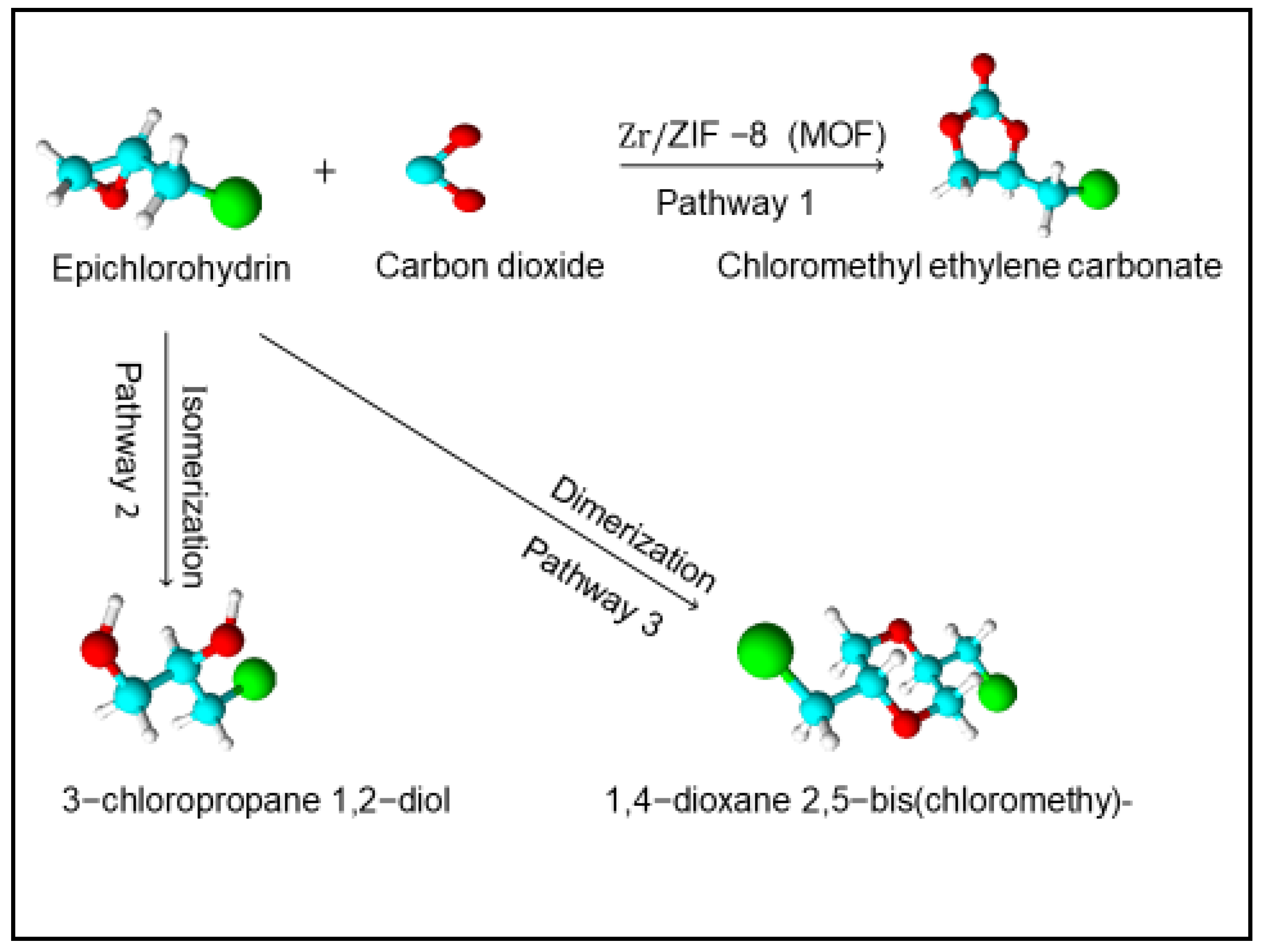

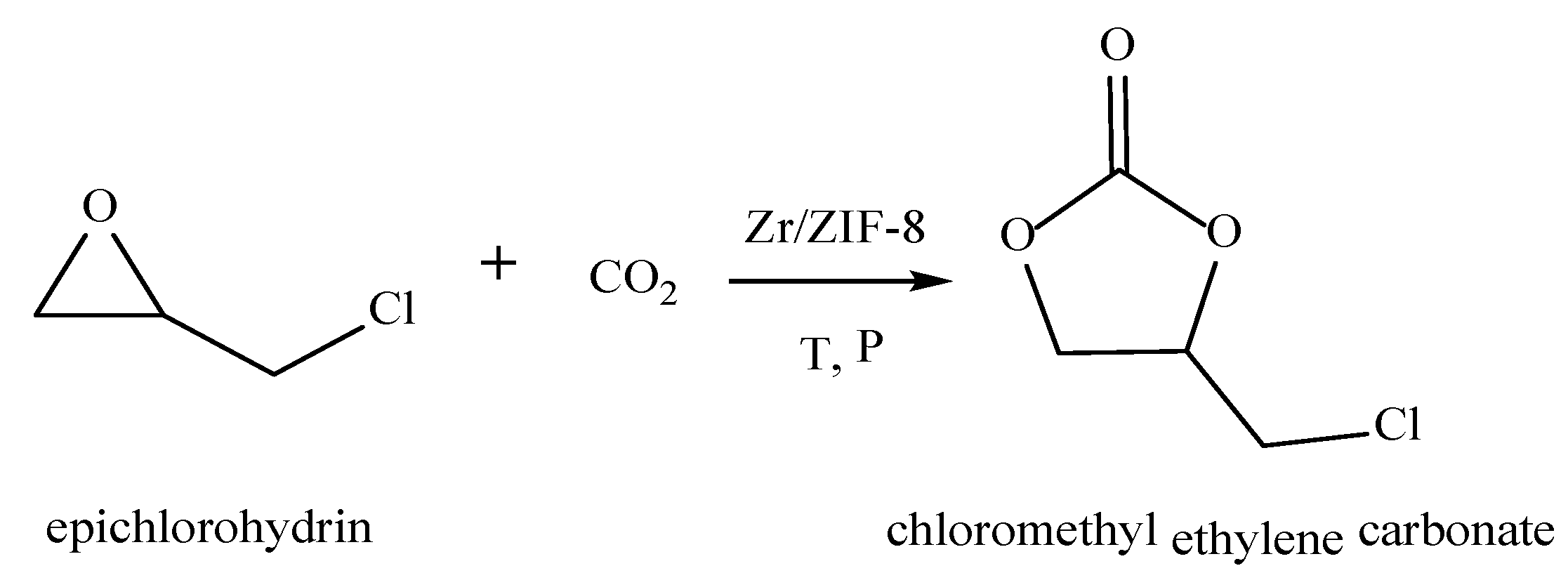

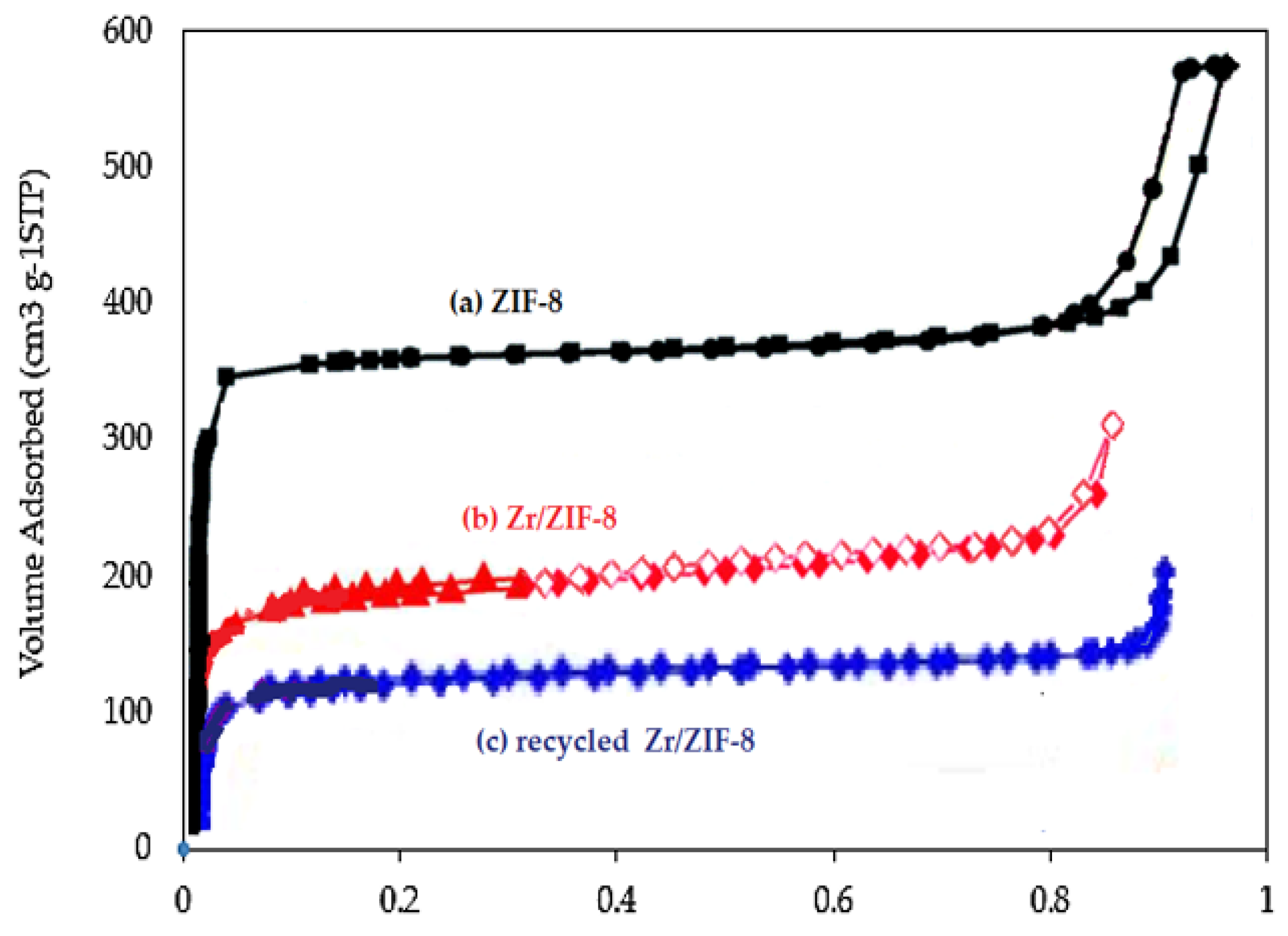
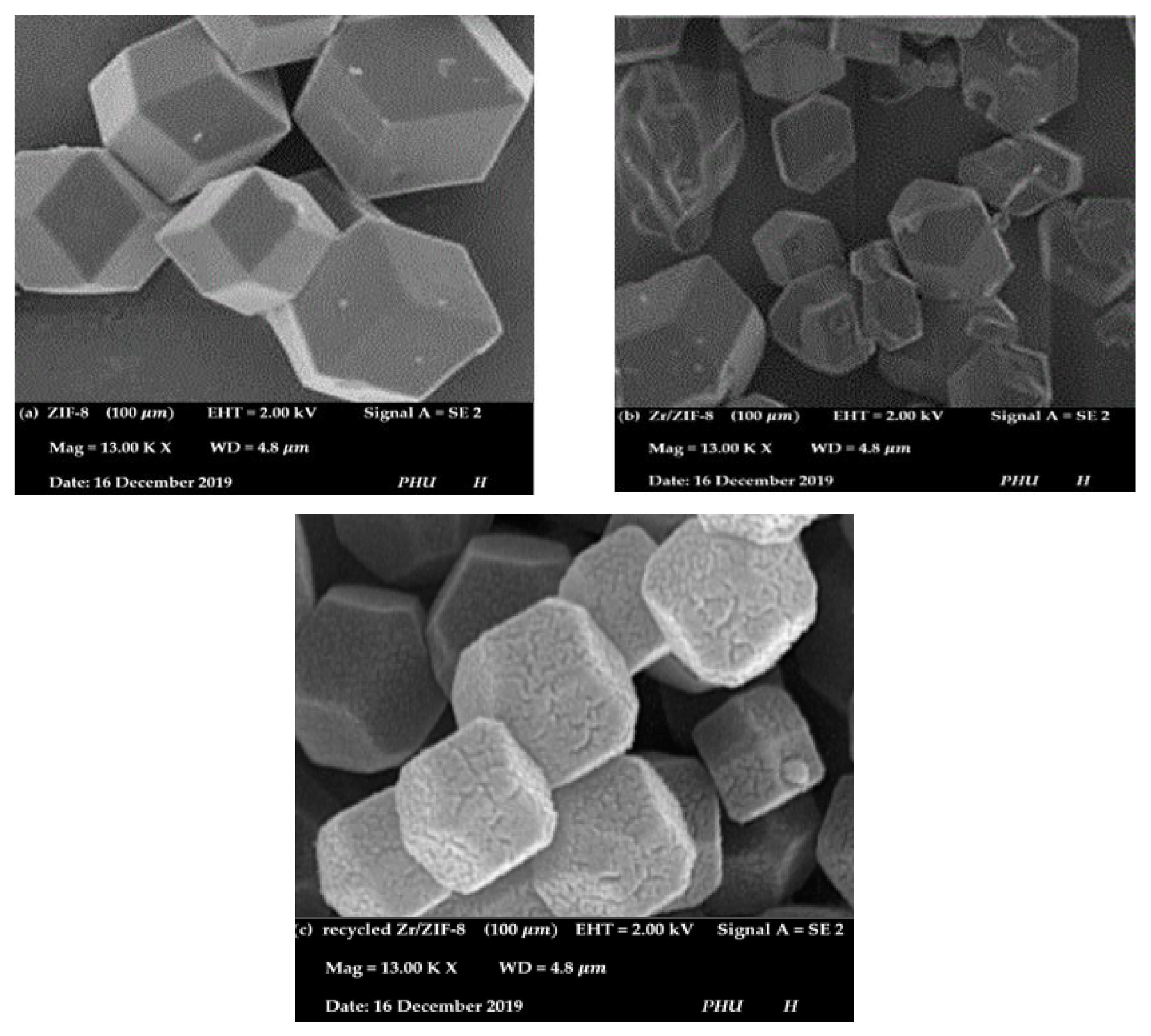
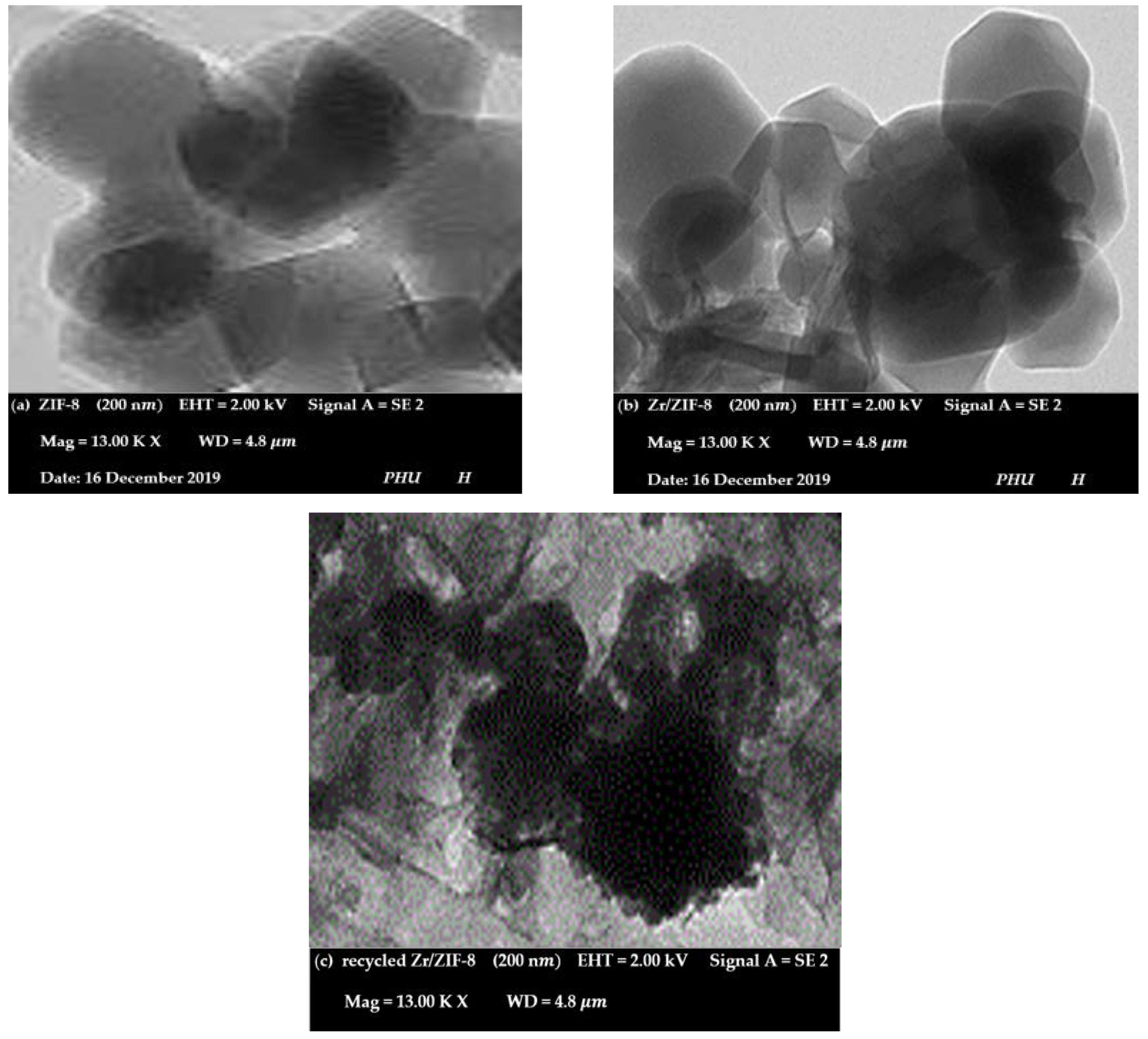
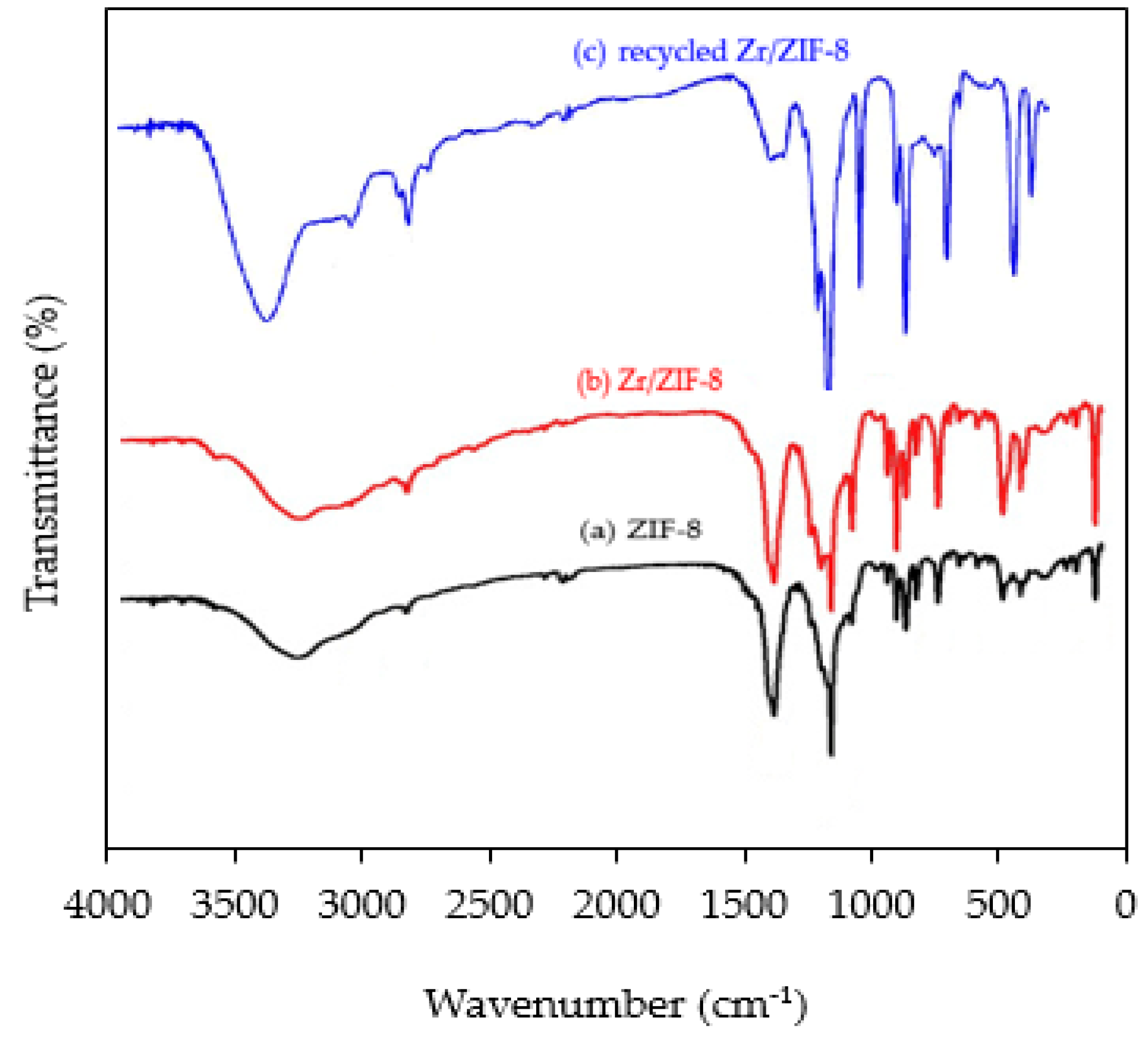

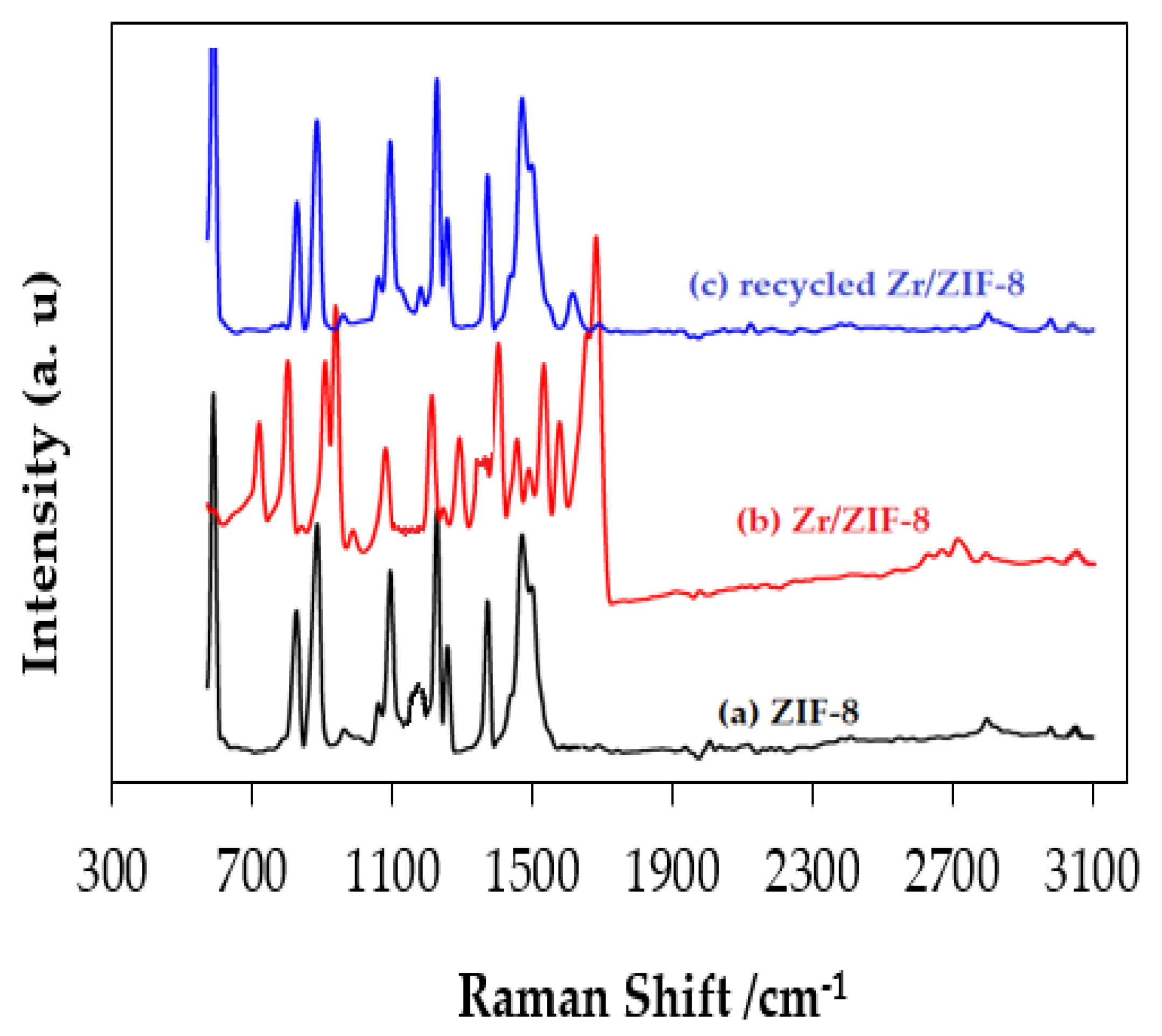


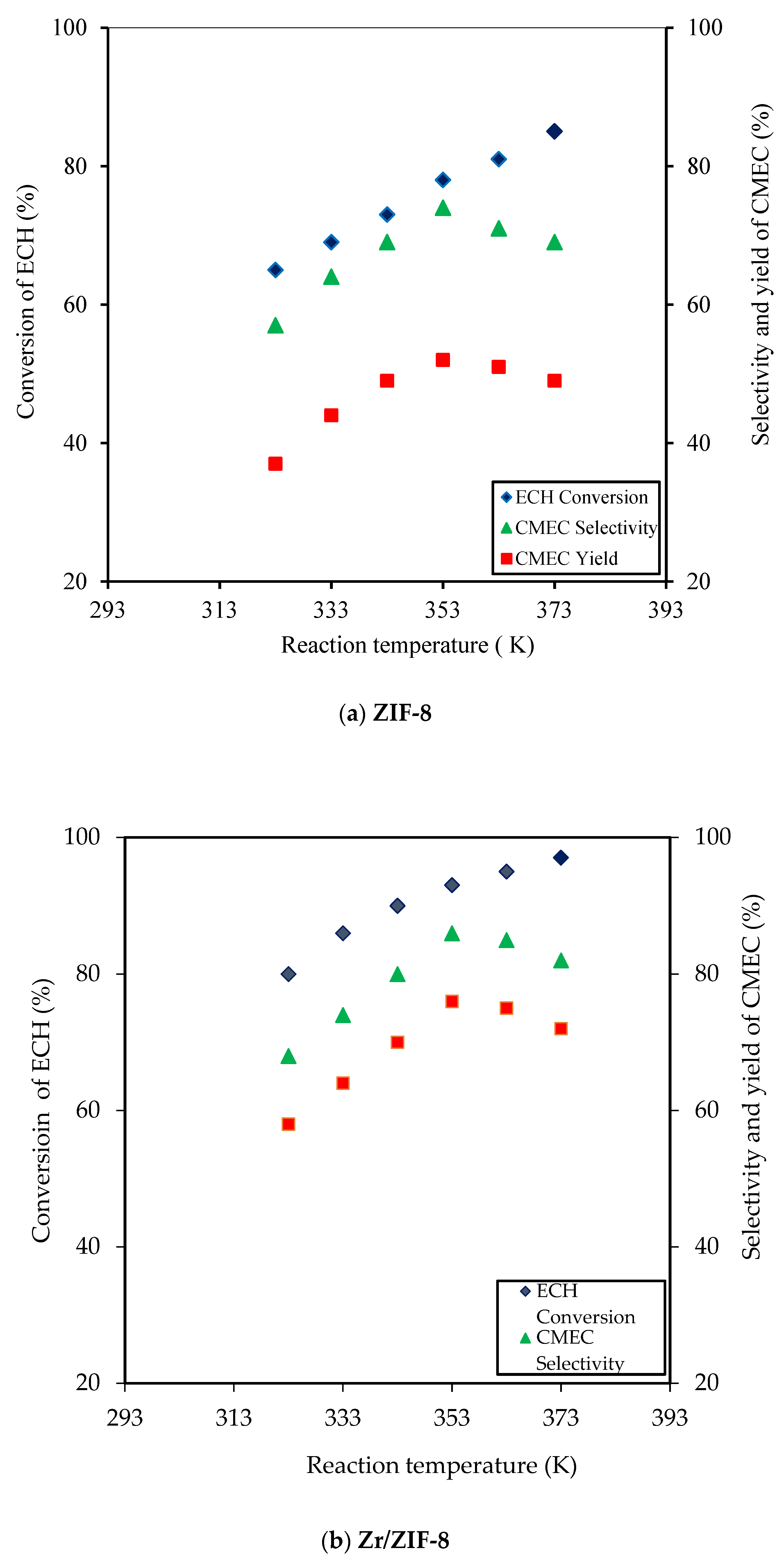
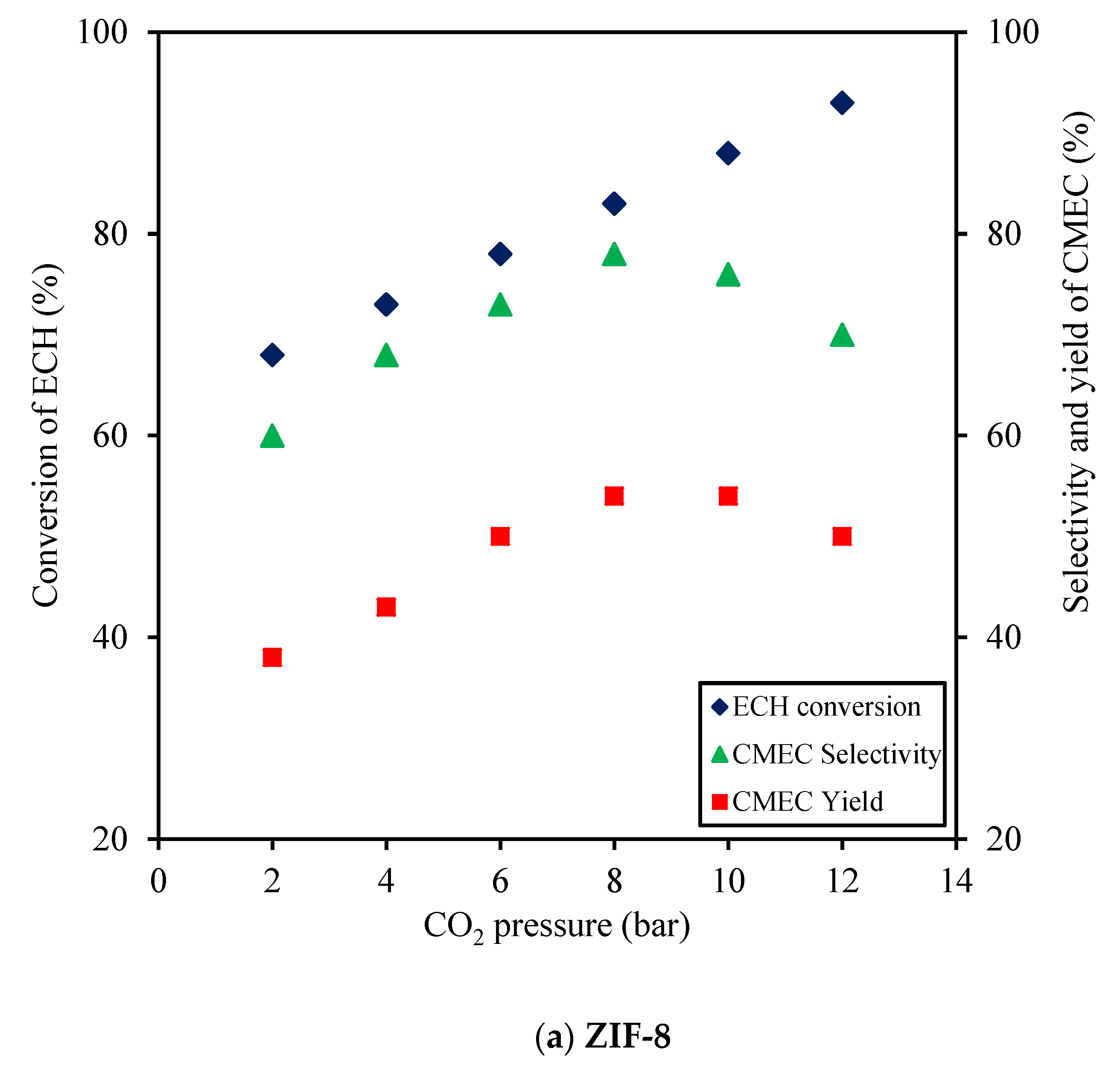
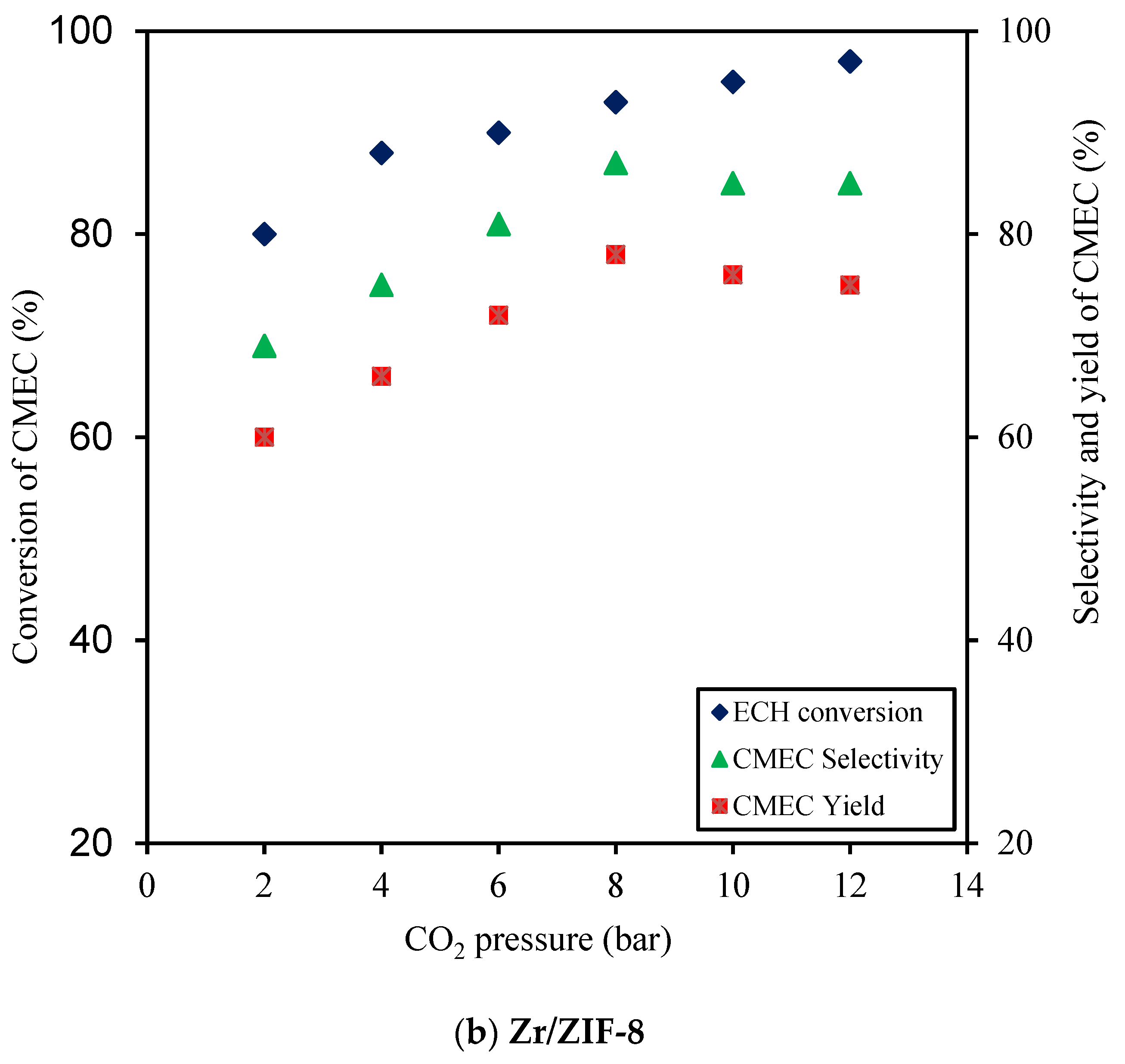

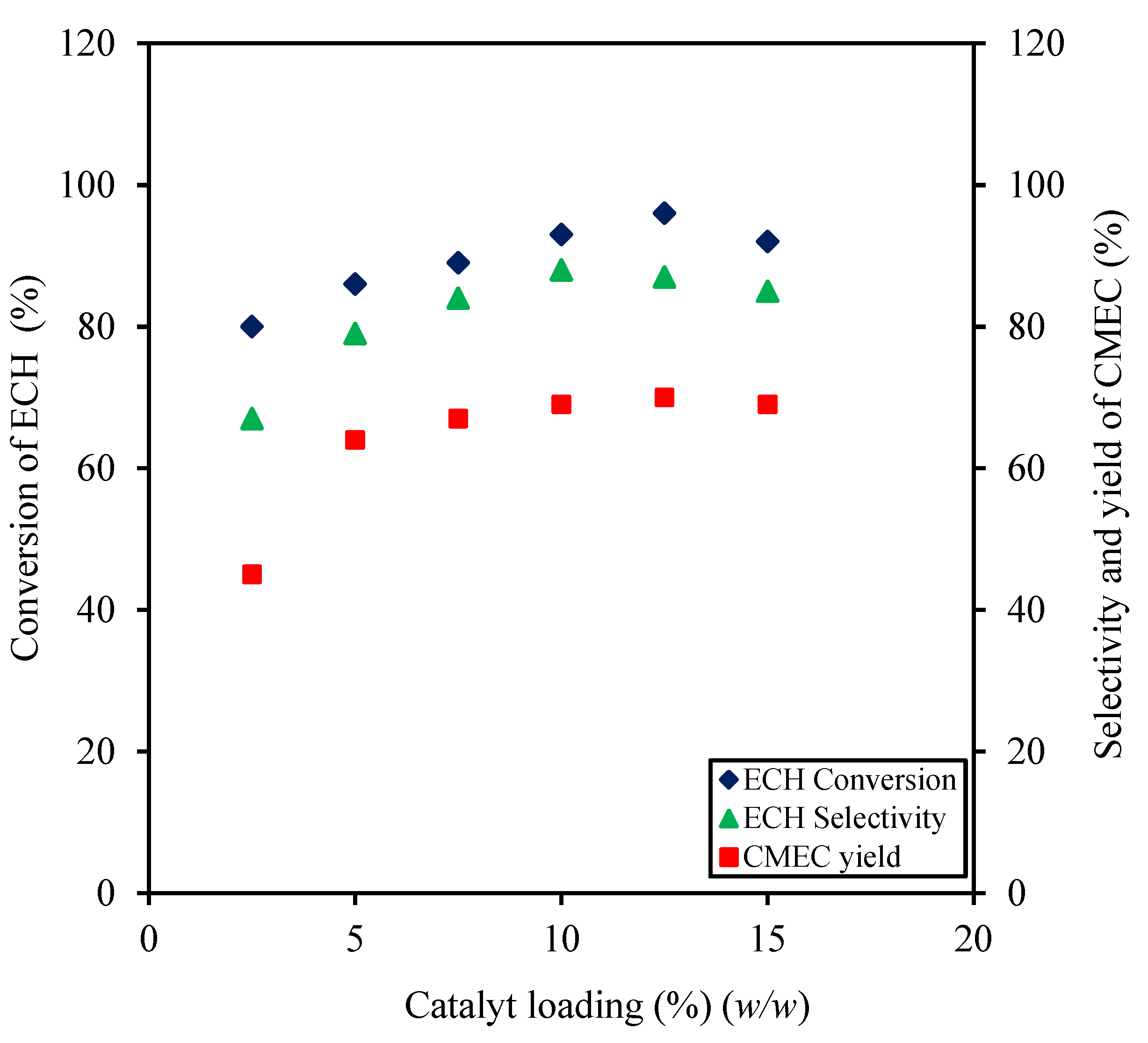
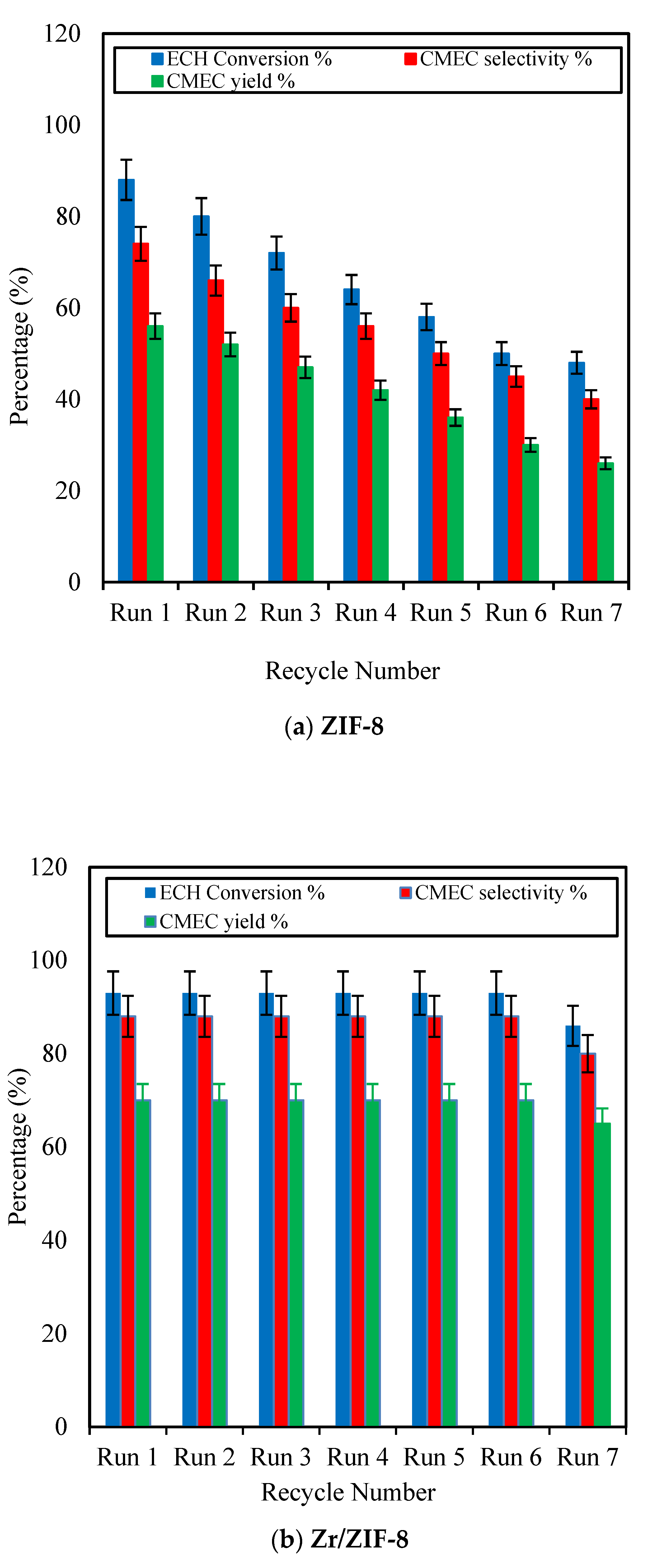
| Entry | Material | S(BET) (m2·g−1) | Pore Volume (cm3·g−1) | Pore Size (nm) |
|---|---|---|---|---|
| 1 | ZIF-8 | 1700 | 0.664 | 1.30 |
| 2 | Zr/ZIF-8 | 1458 | 0.536 | 1.23 |
| 3 | Zr/ZIF-8 (recycled) | 1378 | 0.498 | 1.21 |
| Entry | Catalyst | T (K) | Conversion (%) | Selectivity (%) | Yield (%) |
|---|---|---|---|---|---|
| 1 | ZIF-8 | 323 | 65 | 57 | 37 |
| 2 | ZIF-8 | 333 | 69 | 64 | 44 |
| 3 | ZIF-8 | 343 | 73 | 69 | 49 |
| 4 | ZIF-8 | 353 | 77 | 74 | 52 |
| 5 | ZIF-8 | 363 | 81 | 71 | 51 |
| 6 | ZIF-8 | 373 | 85 | 69 | 49 |
| 7 | Zr/ZIF-8 | 323 | 80 | 67 | 58 |
| 8 | Zr/ZIF-8 | 333 | 86 | 74 | 64 |
| 9 | Zr/ZIF-8 | 343 | 90 | 80 | 70 |
| 10 | Zr/ZIF-8 | 353 | 93 | 86 | 76 |
| 11 | Zr/ZIF-8 | 363 | 95 | 85 | 75 |
| 12 | Zr/ZIF-8 | 373 | 97 | 82 | 72 |
© 2020 by the authors. Licensee MDPI, Basel, Switzerland. This article is an open access article distributed under the terms and conditions of the Creative Commons Attribution (CC BY) license (http://creativecommons.org/licenses/by/4.0/).
Share and Cite
Olaniyan, B.; Saha, B. Comparison of Catalytic Activity of ZIF-8 and Zr/ZIF-8 for Greener Synthesis of Chloromethyl Ethylene Carbonate by CO2 Utilization. Energies 2020, 13, 521. https://doi.org/10.3390/en13030521
Olaniyan B, Saha B. Comparison of Catalytic Activity of ZIF-8 and Zr/ZIF-8 for Greener Synthesis of Chloromethyl Ethylene Carbonate by CO2 Utilization. Energies. 2020; 13(3):521. https://doi.org/10.3390/en13030521
Chicago/Turabian StyleOlaniyan, Bisi, and Basudeb Saha. 2020. "Comparison of Catalytic Activity of ZIF-8 and Zr/ZIF-8 for Greener Synthesis of Chloromethyl Ethylene Carbonate by CO2 Utilization" Energies 13, no. 3: 521. https://doi.org/10.3390/en13030521
APA StyleOlaniyan, B., & Saha, B. (2020). Comparison of Catalytic Activity of ZIF-8 and Zr/ZIF-8 for Greener Synthesis of Chloromethyl Ethylene Carbonate by CO2 Utilization. Energies, 13(3), 521. https://doi.org/10.3390/en13030521






